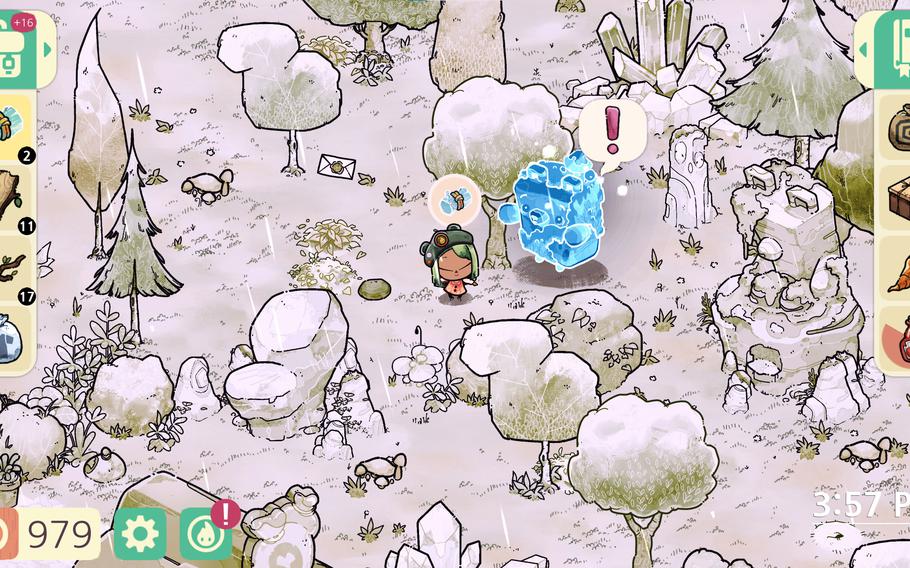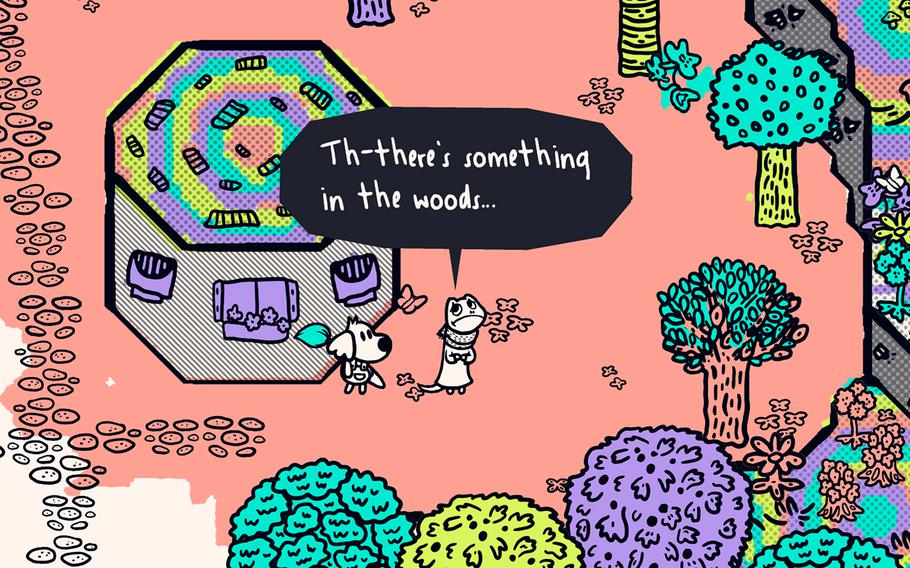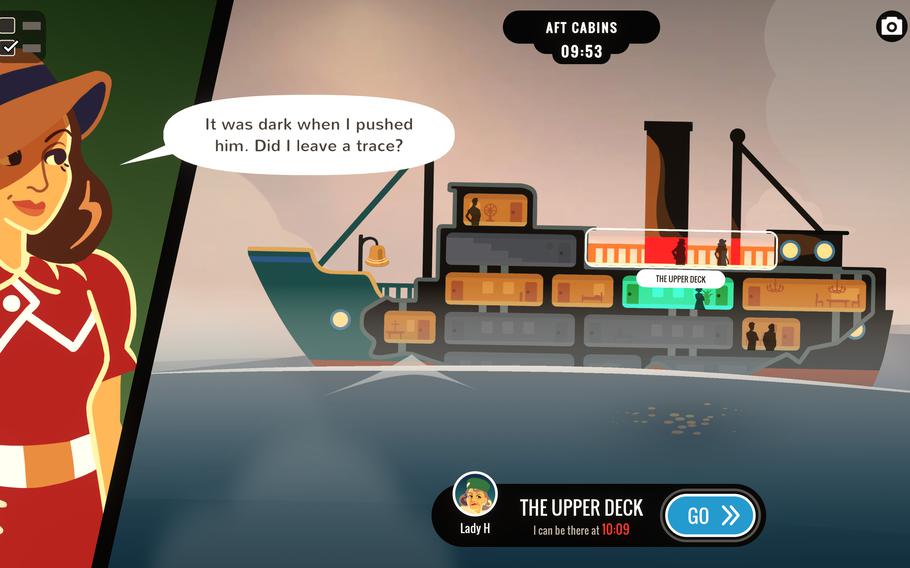
In Cozy Grove, players bring an island paradise to life by helping bear characters face reality to heal their lost souls. (Spry Fox)
Cozy Grove arrived in the spring as an Animal Crossing-inspired game with a bittersweet tone, characters struggling with unresolved trauma and bite-sized missions.
Now, it’s become a ritual.
Cozy Grove, available for iOS devices, PCs and all major consoles, is often what I reach for first thing in the morning, a pre-coffee digital relaxant to ease into the world of the awake with daily lessons about attempting to live a life free of regrets. Most of the game’s characters are bears, and they’re dead — spirits — many struggling with remorse or shame that’s carried over into their ghostly state.
These bears worry about ailments. They hate the way they look. They wish the living would stop treating them like ghosts rather than fully capable beings. They find out everyone was scared to tell them their baked goods were inedible.
Yet as anyone who has ever played Super Mario Bros. knows, games are metaphors. A treatise on the power of family, the struggle of the 9-to-5, the ability to find surrealism in daily life and a reminder to not give up on true love regardless of the obstacles — that’s the Mario message, right?
In Cozy Grove, by helping the bears face reality, or sometimes simply the better parts of nostalgia, we heal lost souls. Doing so brings an island paradise to life, populating it with all the colors of a natural, wildlife-inspired spectrum. A bleak world of driftwood becomes a mystical campground, and we advance through the game essentially by building more mindful bears. As in Animal Crossing, we craft objects, go fishing and mostly hunt for lost items, but the story progresses simply by listening and becoming something akin to a therapist for the spirits.
It’s thoughtful, a game that, like many released in recent weeks, possesses a healthy conscience. While independent games long ago helped popularize the idea of concocting digital worlds built primarily for exploration, a so-called “wholesome games” movement — led by a social media account and site of the same name — has created a makeshift genre that’s brought more visibility to games in which the joy is uncovering a universe rather than obliterating it, often with ideas on how to be better custodians of our current one.
At the very least, Cozy Grove and other gentle games such as the coloring-book-like adventure Chicory: A Colorful Tale and the run-away-from-home fairy tale The Wild at Heart are conversational, using gameplay that deviates from running and jumping and pointing and shooting to get players to slow down and engage in an interactive dialogue with what’s on the screen. They’re games that don’t just extend a hand; they feel like a hug.
Across its various social media platforms, Wholesome Games has tallied more than 200,000 community members, and a recent online showcase, Wholesome Direct, provided looks at more than 75 games. They were diverse in genre and style, ranging from Beasts of Maravilla Island, a calming and beautiful celebration of mythical animals, which is available now, to the upcoming Lake, a game about a woman who quits her fancy job to be a mail carrier.
“Folks are curious to know ‘why now?’ with regards to an influx of wholesome games,” says Matthew Taylor, independent game developer and founder of Wholesome Games. “As much as I’d love to take the credit, I genuinely think that the desire for these types of games has always existed.”
Taylor and others partly attribute the popularity of Wholesome Games’ online events to some of the same factors that led to the rise in indie games: the proliferation of university video game development programs, lower costs to develop games and the ubiquitousness of mobile games, which turned many of us into gamers and inspired some to be curious about and more deeply investigate the medium. Another factor is the pandemic, with old and new players alike looking for accessible, connective experiences that de-emphasize violence.
One more crucial shift is a long overdue acknowledgement that games and their action-focused genre classifications — shooters, platformers, roguelike — have catered to a specific, existing community rather than seeking to more broadly build a new one. Don’t worry if you don’t know what the above genres mean; as others have noted, they don’t tell you much about the game.
“At the end of the day, I think these narratives are interesting and partially true,” says Taylor when asked why an estimated few hundred thousand tuned into this year’s Wholesome Direct. “But they let an industry that’s been catering specifically to young white men for almost its entire existence off the hook.” A wider audience has “always existed. Now the games are finally catching up.”
While the word “wholesome” has generated a debate over genre names and what to include or exclude, the movement feels revolutionary for the game space; unlike film, books or television, game genres have often been defined by what they ask the player to do rather than what they may want the player to feel. “Wholesome,” like the words “punk,” “hip-hop” or “rom-com,” isn’t a brand so much as a welcome mat to someone looking for something to play.
For the Seattle-based Spry Fox team behind Cozy Grove, such terminology, particularly the word that graces its game, has become something of a mission statement. Cozy Grove, for instance, recently added the ability to hug a bear.
“We’re hoping to take this to the next level and do a large-scale Animal Crossing-like game that will bring people together and hopefully make them feel less lonely, in addition to feeling cozy,” says studio co-founder David Edery. “The absence of loneliness and coziness are very interrelated. We’re feeling like this is a thing that we want to dedicate ourselves to for the next several years.”
Cozy Grove, The Wild at Heart and Chicory are three of my favorite games of 2021, and one thing they all share is accessibility. I don’t believe in “casual gamers” — play, after all, is the first language we develop as children — but I do believe there are people who see a video game screen and feel overwhelmed. I play Cozy Grove on my iPhone since it’s part of the Apple Arcade subscription service, and The Wild at Heart and Chicory are also games built not just for reflection but for sharing with others.
They’re games that, like the best fairy tales, understand that seriousness and a sense of childlike wonder aren’t mutually exclusive. “Once we realized these characters were going to be ghosts and have past trauma, then it became exciting for us to figure out how to tell that in a way that was cozy,” says Edery. “It’s not a trivial thing. Talking about a character that has survivor’s guilt is not a cozy topic, but the friendship you develop, how you help them, how you walk them through what they’re feeling, that became cozy.”
The Wild at Heart, available for PCs and Xbox consoles, has generated comparisons, with good reason, to Nintendo’s Pikmin franchise. Players round up a group of helper characters, in this case forest sprites, and call on them to clear paths, carry items or sometimes battle an evil creature until it helpfully disappears. The small studio, whose staff is spread primarily throughout the Pacific Northwest, wanted a tone that was part “Where the Wild Things Are,” and part those of the animated films of Irish studio Cartoon Saloon (“Wolfwalkers”).
The result: melancholic magical realism. We encounter what could stereotypically be defined as a “crazy cat lady,” only this idealized nomadic figure knows the secrets of nature and inspires the imagination of our young protagonist, Wake. The video-game-obsessed kid with a troubled childhood wants to reconnect with his dad who spends evenings watching old home videos of better days while drinking away his future.
This sounds ... not fun, but that’s only because we speak of games in frivolous language. The Wild at Heart is, in fact, a cause to rejoice, and I smile at the details in almost every screen, as well as Wake’s ability to pretend, his desire to trust and his escape into a hidden world of magic that’s in danger of succumbing to the chaos of humanity. Everything in “The Wild at Heart” feels delicate, from Wake’s well-being to the tragic, living fire beings that threaten our health.
Like a Pikmin game, one could talk about The Wild at Heart for its puzzles or strategy — how one can trigger music, inspire sprites to build bridges or discover new items to build — but it’s really a story about childhood friends learning, through the help of sorcerer-like vagabonds, that our past mistakes don’t have to define the future with those we’ve hurt and those we love if we’re open to learning. And through the outlandish characters and creatures we meet, we remember that for all the troubles in the world there’s whimsy too.
“This was always the story we were going to tell,” says Chris Sumsky, co-founder of The Wild at Heart developers Moonlight Kids. “It wasn’t actually a ‘Pikmin’-style game to begin with. Pikmin games are awesome, but they don’t have a lot of story. So it became a ‘what if’ scenario. What if you take Pikmin, and you wrap it in an actual deep story that people care about? Then you can bring people into the game from the story.”

In Chicory, players learn that art heals. (Finji)
That’s how Chicory hooked me. On the surface, Chicory, available for PCs and PlayStation consoles, is an adventure game inspired by The Legend of Zelda, in that we travel among forest towns and caves on a quest to heal the land. But it’s also a game about believing in the power of art, the surprise or astonishment that comes from an attempt to draw or paint, and the sometimes paralyzing stress of having to live up to others’ expectations for ourselves.
In Chicory, we don’t have a weapon; we have a paintbrush. Color has been stripped from the world, and the town’s famous artist, Chicory, has locked herself away in her bedroom, her love of art suddenly vanished. We play as an apprentice, a dog, whose ability to paint hasn’t won the favor of the townfolk, but it doesn’t take crafting a masterpiece to bring color to the world and use our brush to inspire plant and wildlife interactions.
Many of the animal characters we meet are struggling with depression. One wants to draw with us on a bench, only to then reveal that “something tiny” has sent them into a spiral. Others are unhappy with the look of their living space. Caves can be foreboding, at least until we light them up in a wash of pastels. In Chicory, we are asked if we make art for personal growth or for the compliments, and we learn that art heals. The game even has optional drawing lessons, and our canvases populate the land.
“I like to start from a simple, familiar place and let those themes grow organically as a conversation between the characters and gameplay develops,” says Chicory creator Greg Lobanov. “I put a lot of emphasis on making sure the characters are reacting honestly to the circumstances the game throws at them. And I always make my games in order, starting at the beginning and making the end last, so that my journey making it mirrors the players’ playing it. It makes it easier to keep it all in my head and maintain that genuineness.”
Especially welcoming is that its difficulty can also be dialed way down, so much so that I skipped any “boss fights,” a gatekeeping relic of early game design in which natural progression is suddenly blocked by a cumbersome challenge. But Chicory even turns its difficulty settings into a sense of play — an in-game hint line is essentially a call to the player character’s parents asking for advice.
How easy or difficult a game should be remains something of an imprecise science, but I also find it’s the first question asked by anyone who is curious about games but doesn’t regularly play. “There aren’t a lot of options for a chill adventure that isn’t super hard or overly gamified with stats,” says The Wild at Heart’s Sumsky. “Our art style certainly affords that. I don’t think anyone looks at this and expects our game to be ultrahard.”

The mobile game Overboard! is a narrative experience in which a woman tries to pin the murder of her husband on someone else on the ship. (inkle studios)
Of course, it should be noted that games under the broad wholesome banner aren’t necessarily antiviolence, even if they don’t use violence as part of their gameplay. Overboard! has become one of my go-to mobile titles for short gaming sessions, and this narrative experience starts with an act of extreme violence: A woman in an unhappy marriage tosses her husband into the ocean. We spend the game simply talking to others on the boat, trying to charm our way out of being caught for murder.
In Say No! More we shout the word “no,” but it’s not a weapon so much as enforcement of professional boundaries as we navigate an insufferable work environment and in turn learn the power of self-worth. The game excels because its elongated, exaggerated art style reminds us that the struggles and stresses of the daily grind are not always worth the anxiety they cause.
Wholesome — or cozy — is simply a way to convey a feeling.
“It’s a nonviolent game, first and foremost,” says Edery. “There’s an image you can put in front of someone, and it will be cozy. You’re indoors. A rainstorm is happening outside. You’re holding a warm mug of cocoa. You’re there with three or four other people you care about. That’s cozy. So can you evoke that sense in one of these games? There are things that are wrong, but you’re inside and they’re outside. If those wrong things are infringing on you, you have tools to deal with them that are nonviolent.”
Violence, it appears, has at long last come to be understood as cliche in the game space.